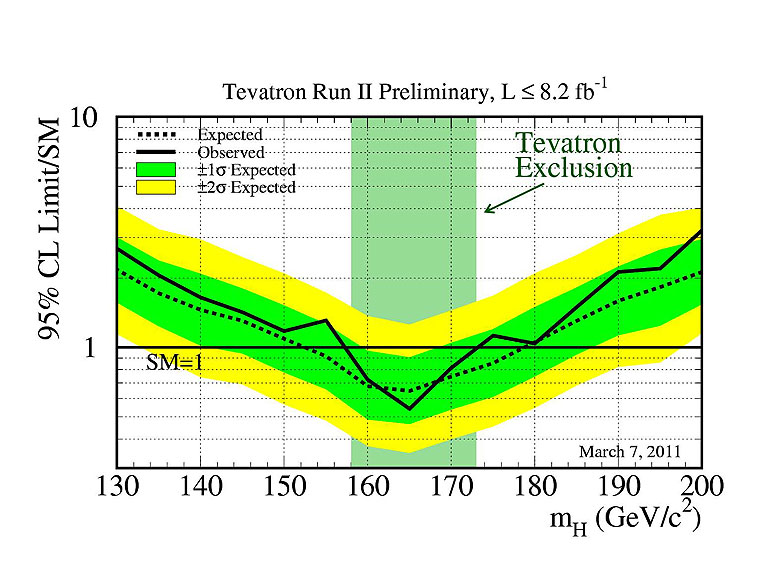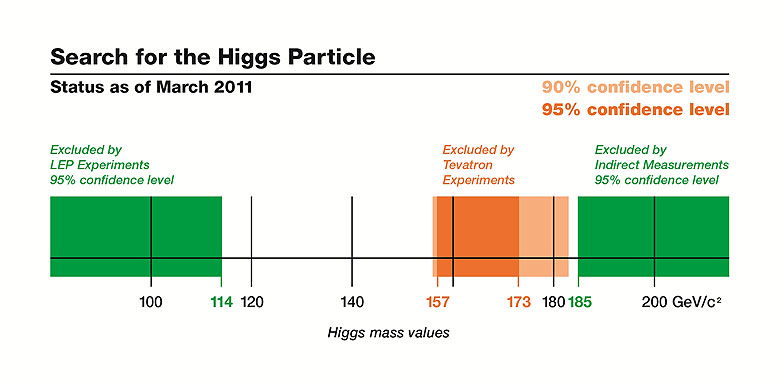... Not really.
What startled me most was that a colleague of mine at the University of Padova even sent a message to my departments' mailing list, saying that the new result is very important. But it clearly isn't! In fact, the exclusion at 95% CL in the range of Higgs boson masses that CDF and DZERO could put together from the analysis of additional data is almost exactly the same as the one that they published last Summer.
But maybe I should make a step back and explain the matter from the start, to let you judge by yourself the relevance of the new Tevatron bounds on the rate of Higgs boson production in proton-antiproton collisions.
CDF and DZERO are analyzing the proton-antiproton collisions at 2 TeV that the Tevatron collider is producing since 2001. They have refined their search tools to a really remarkable level, such that they in some cases even out-performed their own optimistic pre-run predictions (ones that I helped put together, so I know what I am talking about). Nowadays, every six months they update their results, adding further small improvements. What matters, however, is by now mostly the added statistics that the searches can study every time they make an update.
The Higgs boson is searched in all the production channels and all the decay modes to which the Tevatron experiments are even marginally sensitive; then, all search results are combined together, and a further combination occurs between results of CDF and DZERO. This allows the Tevatron experiments to produce combined search results with the highest possible sensitivity.
All searches matter, but among the search channels that are most relevant, the direct production of Higgs boson with a subsequent decay to W boson pairs, and the latters' production of two lepton-neutrino pairs, is the one which provides most of the sensitivity in the only region where the Tevatron has produced a 95% upper limit below the predicted Standard Model rate, thus ruling out the existence of the Higgs at those particular mass values. This is shown graphically in the figure below.

In this "brazil band plot" you can see a black curve as a function of Higgs mass. This curve determines what production rates of the Higgs are excluded: those above the curve. Since the y axis is normalized such that the expected standard model production rate is at unity (such that what is effectively drawn is the rate in units of "times the SM predicted rate"), this means that when the curve goes below 1.0 the corresponding mass values are disfavored, at 95% confidence level.
Now, this means, for the graph you just saw, that the Tevatron is now excluding the mass region 158<M(Higgs)<173 GeV. Compare with the summer 2010 results: 158<M(Higgs)<175 GeV. The new result is actually excluding less than the old one! What's going on here ?
Quite simply, the added data happened to "over-fluctuate" ever so slightly, so that, once added to the old data, pulled the limit up instead than down. This resulted in a narrower exclusion than the previous one!
This is slightly unfortunate, but quite possible. In fact, the green band shows the range of where Higgs limits could be set with the available data and analyses. What I find embarassing is that one should "justify" oneself for this fluctuation, or plain claiming that the new result is very important! It is not, but it happens. The next one might be more important.
Instead, what I see now happening in the press office at Fermilab is what I observed in other laboratories toward the end of life of experiments: overstatements, overhyping. Not good.
What do I mean ? Have a look at the Fermilab Today site. The article there is slightly over the top for my very personal taste, for two or three reasons.
One: they stress too much that the expected limit by the experiments was wider than the observed one. Come on, the black line is within the 1-sigma band throughout in the relevant region... It happens, get it over with! No need to stress such a detail! Here are the relevant quotes:
"Statistical fluctuations in the number of observed particle collisions that mimic a Higgs signal, mixed with collisions that may have produced a Higgs boson, affect the actual range that can be excluded with 95 percent certainty. Combining their independent Higgs analyses, the two experiments now exclude a Higgs boson with a mass between 158 and 173 GeV/c2."
And in the figure caption:
"Combined the Tevatron experiments now are sensitive to a Higgs mass from 153 to 179 GeV/c2, but statistical fluctuation reduce the actual mass range that can be excluded so far."
Two: they go as far as to quote, in addition to their ten-year standard 95% confidence level limit, the limit at 90% confidence level (see graph below), which does extend further in the high-mass region. It shows clearly that they ache for the standard limit (at 95%CL) just kissing the 1.0 line from above (see figure above)... which means a narrower excluded region than it would have been with just a bit more "luck". But quoting a 90% CL is a post-data decision and I strongly blame them for such practice! To explain why this is highly reproachable, ask yourself whether they would have quoted the 90% confidence level limit if it had not been wider... The question answers itself.

Finally, in the above figure they include an "indirectly excluded region" on the right of the 185 GeV point. I think that information should not be mixed with direct search results on the same footing! It again shows their urge to overhype the new result.
Ok, diatriba mode off. I am still quite willing to say that the Tevatron rocks, and that the games for the Higgs search are not over just yet!



Comments